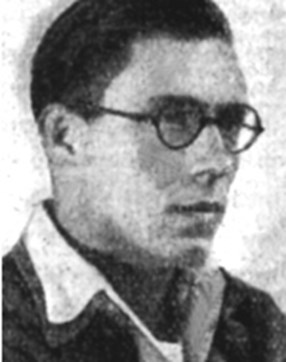


In memory of Corporal Amnon Zilbershpitz
Born in Szászrégen, Romania, 22nd of Elul, 5648 (September 21, 1924). Fell in Beit Guvrin, 22nd of Tishrei, 5709 (October 25, 1948)
Amnon Zilbershpitz came to Israel in order to build a new life after his entire world was destroyed in the Second World War. The film captures the moving moments when Amnon and Sarah, his beloved Sabra, meet.
For the Educational Guide Click here>>
Amnon was born in 1924 in the city of Szászrégen in northern Transylvania, Romania. He was called Edouard in those days. His parents, Belinka and Yosef, were an upstanding family in the small and close-knit Jewish community of 1,635. In the summer of 1940, in accordance with the terms of the Vienna Award which Germany and Italy forced on Romania, the northern district of Transylvania was ceded to Hungary. The anti-Semitic laws that were passed in Hungary, which resembled the Nuremburg laws, were thus also applied to the Jews of Transylvania. They suffered from social and economic discrimination; their basic civil rights were denied.
After the conquest of Hungary by the Germans, the Jews of Szászrégen were instructed to move into the ghetto where Jews from other towns in the vicinity were also confined. A month later, they were all sent to Auschwitz, along with the rest of the 131,000 Jews in northern Transylvania. Most of them were killed.
 Amnon Zilbershpitz z"l |
Amnon, his parents and his siblings were also sent to the extermination camp. Immediately on arrival, they were separated. Amnon never saw the rest of his family again: all of them were murdered. Only Amnon was sent to work and survived. After liberation, he spent some time in a displaced persons camp but every step he took reminded him of the pain and memories of his past. He decided to leave everything behind and come to the Land of Israel.
Amnon made his way to Italy and received permission to board the ship “Dov Haus” (“Fada”). However, after he was already on the ship, he gave up his spot for the sick and the children and returned to shore. Only a few months later did he reach Israel—this time illegally—on the ship “Josiah Wedgwood”.
On his release from the Atlit detention camp, he joined Kibbutz Dorot in the Negev. There, in the carrot fields, he met Sarah, a Sabra from Jerusalem. The two became a couple and planned to marry.
On November 30, 1947, a day after the announcement of the UN Partition Plan, Amnon wrote to his fiancée: “If so, my darling, this land is ours. There is great joy but no one knows what tomorrow will bring and what the response of the Arabs will be.” And: “My dear, you wrote to me to ‘be strong’. You know that I have endured so much that there is nothing that can frighten me.”
In January 1948, Amnon joined the Givati Brigade—the 5th Brigade in the Haganah organization. During the War of Independence, Beit Gubrin and the local police station were captured by the Egyptian army. It was decided to recapture the police station where Jordanian soldiers were stationed. The mission was assigned to the 52nd Battalion of Givati, which attacked the police station on the 22nd of Tishrei 5709 (October 25, 1948) on half-tracks. With a number of explosions, the Jordanian soldiers were neutralized and the building was captured.
While manning a machine gun to cover his comrades who were assaulting the police station, Amnon was killed by a bullet to the neck. He was 24 years old and a “Netser Aharon”—a Holocaust survivor who was the last remnant of his nuclear family.
Thoughts from Ofer Vinter and Shimon Angel of the Dov Abramson Studio who created the film:
The story of the “Netser Aharon” victims—Holocaust survivors who arrived alone in the Land of Israel, fell in defense of the young nation and sometimes did not even know any Hebrew—is one of great drama. The drama has two sides. First, their stories leave a feeling of lost opportunity and even horrible luck: an individual survives the horrors of the Holocaust and reaches what is ostensibly a safe haven; but his young life ends on the battlefield, defending a country that he hardly got to know. To that is added the fact that he is not remembered or memorialized. They did not leave any descendants or family behind. In a single moment, the chain of generations is broken and there is no one to tell their story.
In our clip, we sought to describe this great drama by means of a small drama: the story of the meeting and the falling in love between Amnon, a Holocaust survivor from Romania, and Sarah, a Sabra. Their meeting in the carrot fields of Kibbutz Dorot prior to the War of Independence is a story of two worlds coming together and of a future together that was lost.
We chose to present the beginnings of their love in which Amnon and Sarah search for a common language. We have intertwined Amnon’s memories and Sarah’s hopes in this story, as well as the reality that separated them and ended everything.